The Wheelchair Guide
Your Wheelchair and Mobility Scooter Resource
What Are Manual Wheelchairs and Why Are They So Popular?
Tuesday, April 13th, 2010
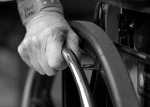 Choosing the best type of wheelchair is something that often comes down to personal preference, although there are certainly a number of other factors involved in this decision, such as physical capabilities and cost. For many, despite the allure of an electric wheelchair, even those heavy duty models that can be driven almost anywhere, a manual wheelchair is still the first choice.
Choosing the best type of wheelchair is something that often comes down to personal preference, although there are certainly a number of other factors involved in this decision, such as physical capabilities and cost. For many, despite the allure of an electric wheelchair, even those heavy duty models that can be driven almost anywhere, a manual wheelchair is still the first choice.
Manual wheelchairs have been used for thousands of years, but the modern design used today is based off of a 1930′s wheelchair called the E&J Wheelchair, developed by Everest and Jennings, two inventors. While there have been many improvements to the manual wheelchair since then, including improved metal working techniques and axle technology, the basic design is quite similar to these early models, which features a hollow metal frame to reduce weight, as well as allowing the wheelchair to be folded when not in use.
A lot of physical effort is required to use a manual wheelchair, which is propelled by the user who pushes on the large rear wheels. A set of hand-rims extends from the wheel, which allows the wheels to be spun easily, without having to touch the part of the wheel that makes contact with the ground. Of course, while many people choose to self propel their manual wheelchair, most also have push handles on the back, so the wheelchair can be pushed from behind.
The front rigging of the wheelchair is the part where the user rests their feet and typically provides two foot rests, although some provide only a single long foot rest, which can be folded up or removed quite easily. A set of parking brakes is also usually attached to the larger rear wheels, which work by simply applying pressure to the wheel and lock in place, holding the wheelchair still.
One of the main improvements to the original E&J Wheelchair has been to the rear axle. The axle connects the two rear wheels, allowing them to spin in unison and makes it possible to move the wheelchair easily in a straight direction, as well as making turning easier. Not only has the axle itself been improved mechanically, but many wheelchairs now offer a movable axle, which allows the user to change the weight distribution of the wheelchair, as well as reducing or increasing resistance.
Of course, cost often also plays a factor, as manual wheelchairs are much less expensive than electric wheelchairs.
A Quick Look At Sports Wheelchairs
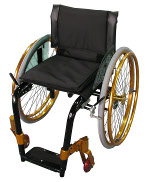 There are many types of manual wheelchairs and one type that has become quite popular in the last 10 or 20 years is the sports wheelchair. Sports wheelchairs come in a variety of designs and styles, including many specialized wheelchairs designed for specific wheelchair sports.
There are many types of manual wheelchairs and one type that has become quite popular in the last 10 or 20 years is the sports wheelchair. Sports wheelchairs come in a variety of designs and styles, including many specialized wheelchairs designed for specific wheelchair sports.
For example, sport wheelchairs designed for wheelchair racing have a very long wheelbase, with the front wheels extending several feet from the rest of the wheelchair, helping to improve stability. Wheelchairs designed for wheelchair basketball, on the other hand, typically have a special metal guard around the chair to protect the user.
Of course, sports wheelchairs do not always have such a glaringly different design and many are simply designed to be as light as possible, while including mechanical upgrades to improve performance. Often, they will feature a more comfortable seat that is made out of a very breathable material, as opposed to the vinyl often used in manual wheelchairs, as well as a lower back or even no back at all. Many find that sports wheelchairs are more practical, even though they don’t play a particular sport.
For instance, for those that work indoors, the lower backrest found on most sports wheelchairs makes it much easier to turn and work around a desk without being inhibited. So, it is common for people to prefer a sports wheelchair over a standard design.
How Manual Wheelchairs Work
Friday, October 2nd, 2009
Wheelchairs have been around, albeit in a much less standard form, for thousands of years. Their roots can be traced back to images of ancient oriental devices, which were designed to provide a way for those who could not walk to get around. Today, despite there being a great number of wheelchair manufacturers around, the general design of the manual wheelchair has become much more standardized.
The modern manual wheelchair is based off of the more than 70 year old E&J wheelchair design, which features a hollow metal tube frame, two large rear wheels, and a smaller set of front wheels. When not in use, the frame can be folded, making it easier to transport and move the wheelchair.
Standard Manual Wheelchair Design
 The large rear wheels allows the user of the wheelchair to self-propel, grasping the rear wheels, which have an extended rim, called a handrim, that does not come in contact with the ground and user to spin the rear wheels.
The large rear wheels allows the user of the wheelchair to self-propel, grasping the rear wheels, which have an extended rim, called a handrim, that does not come in contact with the ground and user to spin the rear wheels.
Even though many manual wheelchairs are designed to be self propelled, this is not always the case. Some manual wheelchairs, called transport wheelchairs or transfer wheelchairs, are designed only to be pushed from behind, so feature much smaller rear wheels. They also have a set of push handles that extend from the top of the wheelchair frame, on both corners of the top seat. Most manual wheelchairs also include these push handles, although sports wheelchairs frequently do not.
The front rigging of the manual wheelchair refers to the footrest and supports, which can often be removed and adjusted to increase comfort. The front rigging varies by wheelchair, but most provide a metal foot rest, which can be folded up to allow the wheelchair user to enter and exit the chair.
A braking system is also present on most standard manual wheelchairs, although sports wheelchairs, which have a slightly different design in general, often do not include brakes. When brakes are present, however, they usually use a simple design that holds the rear wheels in place using a simple vice, which is applied separately to both wheels. This allows the person using the wheelchair to easily set the brake, with only a little pressure.
Anti-tip casters are another important feature, which extend from the rear of the wheelchair frame. They are basically like little arms, which are designed to make contact with the ground if the wheelchair tips over too far backwards. The anti-tip casters can not always prevent a fall, but they often make tipping over backwards much less dangerous.
Sports Wheelchairs vs Manual Wheelchairs
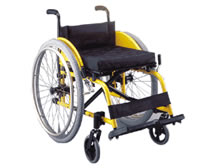 More and more, the sports wheelchair is becoming popular, not just for those who play wheelchair sports, such as wheelchair basketball or wheelchair racing, but also those who simply find sports wheelchairs more comfortable and practical. One major difference between sports wheelchairs and manual wheelchairs is the seat design.
More and more, the sports wheelchair is becoming popular, not just for those who play wheelchair sports, such as wheelchair basketball or wheelchair racing, but also those who simply find sports wheelchairs more comfortable and practical. One major difference between sports wheelchairs and manual wheelchairs is the seat design.
Manual wheelchairs usually use a vinyl like material, which is sewn around the hollow tubed frame. Sports wheelchairs, on the other hand, often use a much more breathable material, which is usually softer and a good deal thicker than the vinyl seat found on a conventional wheelchair. This makes it more comfortable and less likely to cause irritations due to sweat, as well as drying much quicker.
Another major difference is the backrest. Most manual wheelchairs have a full backrest, which sports wheelchairs usually have a much smaller and lower backrest. This is one of the features that many non-sports playing wheelchair users appreciate, because it can be much more comfortable and practical indoors, allowing for a much larger range of movement in regards to the arms and shoulders. This can be important when working at a desk, as it allows the wheelchair user to reach around easily.
There are many other differences between sports wheelchairs and manual wheelchairs, including how the front rigging is designed, as well as the size and angle of the wheels. The axle is usually much different on a sports wheelchair as well.
Manual Wheelchairs Explained
Wednesday, September 2nd, 2009
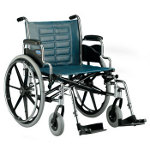 The wheelchair has been used in some shape or form for thousands of years, however over the last 100 years, the technology behind the wheelchair has been greatly improved and a standard created for manual wheelchairs. Despite the increasing popularity of electric wheelchairs, manual wheelchairs remain to be the most popular mobility vehicle used by those who have difficulty walking.
The wheelchair has been used in some shape or form for thousands of years, however over the last 100 years, the technology behind the wheelchair has been greatly improved and a standard created for manual wheelchairs. Despite the increasing popularity of electric wheelchairs, manual wheelchairs remain to be the most popular mobility vehicle used by those who have difficulty walking.
Manual Wheelchair Basics
The manual wheelchair of today is based off of the E&J manual wheelchair design, which was first developed and sold during the 1930′s. Most use hollow steel tubes, or another light but durable metal, for the frame of the wheelchair.
The frame is designed in a manner that allows it to be folded up when not in use, allowing a manual wheelchair to be placed into the trunk of a car. By using the lightweight metal, it is often possible for the wheelchair user to transfer into a car or van, putting up their wheelchair without assistance.
The seat is most often made out of thin piece of vinyl that attached to the frame securely with stitching. Other fabrics are available and becoming more popular, with stain resistant breathable materials being very popular. Since the seat and backrest are made out of a thin piece of fabric, it does not get in the way when the wheelchair is folded up.
Footrests extend from the front of the wheelchair and are attached to the frame of the wheelchair. The footrests can often be removed from the frame completely or folded when not in use, making it easier to transfer into and out of the wheelchair. The footrests and the bars that hold them in place are referred to as the front rigging.
Self Propelled Wheelchairs vs Transport Chairs
Self propelled manual wheelchairs have large rear wheels and smaller front wheels. The large rear wheels have a rim that surrounds them, allowing the wheelchair user to grasp the rim and turn the rear wheels. This allows the wheelchair to be moved and turned, but does not require the person touch the part of the wheel that makes contact with the ground, which would be unsanitary, or risk tangling their hands in the wheels spokes.
Transport wheelchairs, on the other hand, have four sets of smaller wheels, because they are designed to be pushed by a caregiver and not self propelled. Two handle bars extend from the top of the seat, allowing a caregiver to walk behind the transport wheelchair and push its occupant.
Many self propelled wheelchairs also have handlebars for caregivers, but this is not always the case, especially on sports wheelchairs.
Anti-Tip Casters
To help prevent falls and the wheelchair tipping over, anti-tip casters are usually installed on the rear of the wheelchair frame. The anti-tip casters are designed so that if the wheelchair is tipped back far enough, the casters make contact with the ground and keep the wheelchair from completely tipping over.
Anti-tip casters are found on most other kinds of mobility vehicles as well, including mobility scooters and electric wheelchairs.
The History of the Modern Manual Wheelchair
Friday, August 21st, 2009
Manual wheelchairs are one of the oldest types of wheelchairs known to man and records of their use can be traced back thousands of years. However, up until the end of the nineteenth century, there was very little standardization when it came to manual wheelchairs and they were often only available to people who had the resources to hire a professional builder.
Wicker and Wood: Early Wheelchair Designs
Towards the end of the nineteenth century, however, the wicker basket wheelchair began to become very popular. These wheelchairs provided a wicker seat for the person using the wheelchair, which had a very long and high back. These wicker wheelchairs had three wheels and were not only incredibly bulky, but also very heavy.
As a result of how these wheelchairs were designed, it was very difficult to transport a wicker wheelchair and it was also very difficult for the person using the wheelchair to move it on their own. Instead, they were forced to rely on nurses and family members to push the wheelchair if they wanted to move around.
In addition to the wicker wheelchairs, there were also several popular wooden wheelchairs, which were also incredibly heavy and difficult to transport, but were easier to self propel than the wicker wheelchair.
The Development of a Lighter Easier to Use Manual Wheelchair
Despite all their flaws, the wicker wheelchair would remain the standard in wheelchair design for over two decades until the 1930′s, when the first foldable tube framed manual wheelchair was developed. This new wheelchair was created by two inventors named Everest and Jennings and would come to be called the E & J Wheelchair.
Harry Jennings set out to build a newer lightweight wheelchair when he saw the difficulties his friend Herbert Everest was having using the standard wicker wheelchair. Together, they came up with a very innovative wheelchair design, which used hollow metal tubes and a foldable frame. By using metal tubes, they were able to create an incredibly strong wheelchair frame, which was also relatively lightweight.
The E & J Wheelchair frame could also be folded up and placed in a carriage or other vehicle, making easily traveling with a wheelchair possible for the first time. As the E & J Wheelchair was being developed, the build up to the Second World War was beginning and the E & J Wheelchair would soon have a number of users.
The First Electric Wheelchairs
The E & J wheelchair was also used as the base of the first electric wheelchair, when inventors in the 1950′s developed an electric motor that could be attached to the frame of an E & J wheelchair. This allowed the E & J wheelchair to be easily turned into an electric power chair and several companies began selling conversion kits for the E & J Frame.
The Wheelchairs of Today
The E & J manual wheelchair quickly became the standard and was used worldwide. Today, E & J wheelchairs are still available and their influence can be seen in virtually all modern manual wheelchairs.
Prescribing a Wheelchair: Follow Up Care
Monday, July 13th, 2009
 When a doctor prescribes a wheelchair to a user, it is very important that the wheelchair fits the needs of the user. It is also very important that the wheelchair user have a great deal of input over the process, because not only must their physical needs be met, but there are a number of other considerations, like where the person intends to primarily use their wheelchair, that should be considered.
When a doctor prescribes a wheelchair to a user, it is very important that the wheelchair fits the needs of the user. It is also very important that the wheelchair user have a great deal of input over the process, because not only must their physical needs be met, but there are a number of other considerations, like where the person intends to primarily use their wheelchair, that should be considered.
It is encouraged that new wheelchair users also talk with experienced wheelchair users and do a good deal of research on their own, because often doctors, while very well meaning, are not very experienced with wheelchairs and have never actually used one for an extended period of time. Due to health and safety concerns, it is very important that the wheelchair fits the physical requirements of the user.
Once the wheelchair arrives, everything should be remeasured and the wheelchair fully evaluated to ensure that it does in fact fit the needs of the user, however the doctors responsibility does not stop here. Instead, the wheelchair and its effect on the user should be reevaluated with each visit to the doctor.
One of the most important things that a doctor should look for is how the wheelchair is affecting the posture of its user. This is often something that can not be seen until after the user has been using the wheelchair for some time. Proper posture is essential for wheelchair users, because overtime a poor sitting position can cause a great number of health problems.
The actual condition of the wheelchair should also be checked and the user should be trained in how to properly maintain and care for their wheelchair. This includes lubricating moving parts, removing and cleaning the components, adjusting the anti-tip casters, and regularly checking the wheelchairs bolts for tightness. Emergency maintenance, such as how to fix a flat tire, should also be shown.
It is also very important that the wheelchair user be trained in how to navigate environmental factors that they might encounter. This includes the ability to move over curbs, navigate steps, and traveling on hills. Proper transfer techniques should also be shown and the user should be trained on how to fall out of the chair and recover. There are several places across the country that offer a sort of wheelchair obstacle course, to help train new wheelchair users and experienced wheelchair users alike.
The doctor should also make sure that the users home area is wheelchair friendly. It may be necessary to widen doors, install ramps, or a wheelchair lift. The doctor should talk with the patient and explain some of the options available.
Evaluating a Manual Wheelchair for Safety and Comfort
Monday, July 6th, 2009
 When ordering a new wheelchair, ensuring that the wheelchair fits the physical requirements of its user is very important for health and safety reasons, but it can also effect mental health.
When ordering a new wheelchair, ensuring that the wheelchair fits the physical requirements of its user is very important for health and safety reasons, but it can also effect mental health.
Ordering a wheelchair is not a decision that should be taken lightly and it is important that the wheelchair user has plenty of input during the process. Once a wheelchair has been ordered, it should constantly be reevaluated to ensure that it is safely meeting the needs of its user. This should be done both the wheelchair user, as well as a doctor.
Once a persons new wheelchair arrives, the prescribing doctor should evaluate the wheelchair to unsure that it is a proper fit for its user. There are a number of adjustments that can be made to the frame to fine-tune the wheelchair, so that the user can gain the maximum mechanical benefit from the wheelchair.
For manual wheelchairs, since they require a good deal of upper body strength to use, the comfort of the arms in relation to the manual wheelchairs drive wheels is very important. This means, that when in the starting position, the users arms should basically be at rest. This will help to prevent cramps and reduce the effort required to use the wheelchair.
The cushion and seat of the wheelchair should also be treated as a single unit, otherwise, you risk the user being too high or low when the cushion is added. Proper seat height is important, because if the wheelchair is too high, not only will it be uncomfortable, but it will also reduce the efficiency of the wheelchair, which makes it much harder to use. If the seat is too low, it can cause uneven weight distribution.
The height of the backrest is also very important. If it is too high, it can restrict the movements of the shoulder and upper body. However, a backrest that is too low will not provide enough support and can result in poor posture.
The overall width of the wheelchair is another important consideration, because a wheelchair that is too wide can result in the user developing poor posture. This is because the individual will have to lean side to side to reach the wheels. Of course, a wheelchair that is too narrow can cause discomfort and sores, so finding the correct median is essential.
A seat that is too deep can also cause problems, as it can reduce circulation and attribute to poor posture. It can also be dangerous, because the weight of the user is not as evenly distributed, resulting in less weight on the thighs.
Sports Wheelchair Parts Diagram
Tuesday, June 23rd, 2009
There are a great number of wheelchairs on the market and it is very important to find one that will fit the needs of its user. The sport wheelchair, or ultralight wheelchair, is very popular, both by people who are very active and those who simply find it easier and more comfortable to use.
*Please Note that some of the items below are not present in the picture, because they are not usually found on a sports wheelchair.
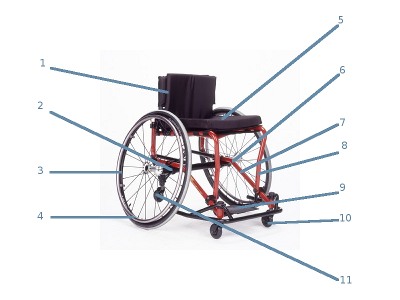
- Backrest
- Rear Axle
- Rear Wheels
- Handrims
- Seat
- Frame
- Traverse Bar
- Front Rigging
- Footrests
- Front Casters
- Anti-Tip Casters
- Brakes
- Tipping Levers
- Seatbelts
- Push Handles
- Upholstry
- Armrests
- Metal Skirt
1. Backrest: The backrest of a sports wheelchair is usually lower than a conventional wheelchair. Typically the backrest will be between 11†and 15â€. The backrest is also usually adjustable and models are also available that span 7†to 11†and 15†to 19â€. A lower backrest can allow for increased upper body movement.
2. Rear Axle: While on a conventional wheelchair, the axle is located directly below the backrest, many sports wheelchairs have adjustable axles. They can be positioned closer to the front of the chair, reducing the wheelbase and making the wheelchair more maneuverable. While typically much more maneuverable and easier to push, a smaller wheelbase also reduces the stability of the wheelchair. To increase stability, at the expense of maneuverability, the axle can be moved backwards towards the rear of the wheelchair. It also makes it a little harder to push, but increase the power of the stroke. Instead of a moving axle, some sports wheelchairs have a moving seat instead.
3. Rear Wheels: The rear wheels are usually the same size as on conventional wheelchairs, but sometimes for racing larger wheels are used. They feature sealed precision bearings and are designed to be as lightweight as possible. This makes the wheelchair easier to move and reduces friction. They also usually feature a quick release button, so the axle can be moved or wheel replaced quickly and easily. Most use spoked wheels, although some sports wheelchairs have solid molded rims.
Typically pneumatic tires are used, often allowing for a much higher pressure than traditional pneumatic tires. Pneumatic tires are great for outdoors, because they provide better shock absorption outdoors. Like racing bikes, the tires are often very narrow.
Often, the camber of the wheel, its angle, is often adjusted, much like you would adjust a sports car, with the bottom of the wheel farther out than the top. This brings the wheels closer to the users body, allowing for more energy efficiency. A wider wheelbase also offers the advantage of a more stable wheelchair that is also easier to steer.
This can pose a problem when indoors when dealing with narrow doorways and makes transporting the wheelchair more difficult. Some now allow the camber to be quickly adjusted to a “toe in†mode for indoor use though.
4. Handrims: The handrims are typically coated in foam that is covered in vinyl, although the rim itself is made of metal. This makes it easier to grab, however the vinyl can be very slick and result in finger burns. More or less padding can also be added, to deliver a variety of grip sizes.
Often smaller handrims are used, which require more energy to get started, but allow for a higher top speed. The smaller handrims also allow for the individual to maintain their speed easier. In many regards the size of the handrim is much like the different gears on a bike.
Sometimes for those with very limited upper body strength or mobility, small extensions are added to the handrail, which extend away from the wheelchair at an angle, making the wheels easier to turn.
5. Seat: The seat often has pieces of velcro attached to it, allowing cushions and bags to be attached. The lower backrest of the seat allows for a greater range of movement and slightly elevates the knees, improving stability.
6. Frame: The frame of a sports wheelchair is made of metals that are very lightweight, such as aluminum, titanium, and graphite. Often, the entire wheelchair will weigh only 25 pounds, which is about half of what a conventional wheelchair weights. There are some, however, that can weigh as little as 15 pounds. The lighter the frame, the easier it is to propel.
Traditionally the frame of sports wheelchairs had been rigid. This improved its performance and made it much sturdier, but it also made it harder to transport. The seat would have to be folded forward and the larger rear wheels would be removed. However, as of late, several manufacturers have begun making folding sports wheelchairs, which makes transportation much easier.
7. Traverse bar: The traverse bar replaces the crossbars found on conventional wheelchairs and helps make the frame sturdier. On folding sports wheelchairs, the frames are equipped with locks to prevent it from folding unless needed.
8. Front Rigging: The front rigging refers to the footrest and the bars that connect it to the frame. Traditionally, the front rigging was not detachable, which improved the stability of the frame. However, this could make transferring into and out of the chair more difficult, some some sports wheelchairs now feature detachable and swing away front rigging.
9. Footrests: The footrest is typically one piece and made of several metal tubes, instead of a platform. It is usually closer to the frame than conventional wheelchairs, reducing the sports wheelchairs turning radius.
10. Front Casters: The front casters are typically made out of solid polyurethane, although some use pneumatic or solid rubber tires. The casters are smaller than those on a conventional wheelchair, usually only 4†to 5†in diameter. However, on racing wheelchairs larger front casters are often used.
11. Anti-Tip Casters: Anti-Tip casters prevent the wheelchair from tipping backwards completely and are often not included on newer wheelchairs.
12. Brakes: Most sports wheelchairs do not have brakes, although some choose to use them. If used, scissor brakes are most popular and mounted lower down on the frame, so the users hand does not become entangled when pushing or the brake accidentally activated. (Not Pictured)
13. Tipping Levers: Typically the tipping lever, which makes it easier for someone pushing the wheelchair to tip the wheelchair backwards and navigate curbs, are much smaller than those on conventional wheelchairs. (Not Pictured)
14. Seatbelts: Seatbelts are usually available for most sports wheelchairs as an option. Some wheelchair users that are very active will use a safety harness to provide more support. (Not Pictured)
15. Push Handles: Many sports wheelchairs do not have push handles, because of the added weight. Instead, fabric straps are added to the back of the seat, to provide a handhold. Some, however, do have push handles. (Not Pictured)
16. Upholstry: Most sports wheelchairs have reinforced nylon or darcon upholstry. This is very lightweight and strong, but unlike vinyl, it is not as easy to clear. (Not Pictured)
17. Armrests: Most sports wheelchairs do not have armrest, which reduces the weight, while allowing the user a better pushing angle. It also increases the users range of upper body movement. (Not Pictured)
If armrests are present, they are usually lightweight and removable. Typically they are not strong enough for the user to use them to transfer into and out of the wheelchair.
18. Metal Skirt: A metal skirt is also usually not present, for both wheelchairs with and without armrests, so the user will risk dirtying their clothes or catching them in the wheels. (Not Pictured)
Other Types of Sports Wheelchairs
There are many different popular wheelchair sports and almost all of these types of sports use a slightly different wheelchair design. For example, the footrest and front rigging of a wheelchair that will be used for wheelchair basketball has a built in foot guard to add more protection. Wheelchairs for wheelchair rugby have an even more protective front guard, as well as more protection around the wheels.
Wheelchairs that are used for racing are elongated to provide stability, so the front wheels often extend several feet from the wheelchairs seat. Since there is so much diversity among the design of sports wheelchair, it is important to decide what you want to use the wheelchair for and to speak with a professional or other wheelchair user to determine what type of wheelchair will be best. It is also not uncommon for many wheelchair users to prefer the design of a sports wheelchair, even if they do not intend to directly use it to play sports.
Manual Wheelchairs for Seniors
Monday, May 18th, 2009
For a senior, walking for extended periods of time can often be very difficult, which is often the result of injuries or in some cases diseases, such as arthritis. Finding a way to increase accessibility and mobility is very important and often a manual wheelchair will offer the least expensive option for a senior.
A Brief Introduction to Manual Wheelchairs
 The wheelchair is probably the most well recognized and well known mobility aid, and its origins can be traced back many thousands of years. However, the modern wheelchair, with its steel tubed frame, two large wheels in back, and smaller wheels in front, is actually a fairly recent inventions. These manual wheelchairs, which can be found at virtually any hospital, store, or airport, are based off of the E & J wheelchair, which was first developed and refined during the 1920′s and 30′s.
The wheelchair is probably the most well recognized and well known mobility aid, and its origins can be traced back many thousands of years. However, the modern wheelchair, with its steel tubed frame, two large wheels in back, and smaller wheels in front, is actually a fairly recent inventions. These manual wheelchairs, which can be found at virtually any hospital, store, or airport, are based off of the E & J wheelchair, which was first developed and refined during the 1920′s and 30′s.
The E & J wheelchair, which features lightweight steel tubing and can be easily folded to make transportation easier, is still around today and serves as the basis for most manual wheelchairs. In fact, early electric wheelchairs also used the E & J design. Today there are many adaptations of the E & J wheelchair and many improvements have been made to increase durability, reduce weight, and improve comfort.
Seniors and Manual Wheelchairs
For a senior, a manual wheelchair is often one of the easiest ways to make getting from point a to point b easier. However, using a manual wheelchair requires a good deal of upper body strength, so as a result, most seniors who use manual wheelchairs rely on a family, friend, or caretaker member to push the wheelchair.
Due to their lightweight and lower cost, manual wheelchairs do make an excellent choice for traveling or going places, like an amusement park, where a lot of walking is required. This is of course, as long as there is someone available to operate the wheelchair.
In addition to the large rear wheels and smaller front wheels, manual wheelchairs also include anti-tip casters. Ant-tip casters extend from the rear of the wheelchair, usually at least six inches from the ground. In the event that the wheelchair is tipped backwards, the anti-tip casters make contact with the ground, keeping the wheelchair from completely tipping over.
Seniors and Transport Chairs
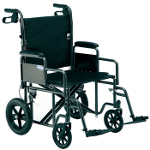 If the senior is not going to be using the wheelchair at all, transport wheelchair, which are also called transfer chairs, are available as well. A transfer chair is similar to a wheelchair, however it does not feature the large rear wheels, which make it possible for the wheelchair user to roll the chair independently, but are instead designed to make it easier for a caretaker or family member to roll the wheelchair. These are often a good choice because they are typically lighter and smaller, making them easier for a caretaker to use.
If the senior is not going to be using the wheelchair at all, transport wheelchair, which are also called transfer chairs, are available as well. A transfer chair is similar to a wheelchair, however it does not feature the large rear wheels, which make it possible for the wheelchair user to roll the chair independently, but are instead designed to make it easier for a caretaker or family member to roll the wheelchair. These are often a good choice because they are typically lighter and smaller, making them easier for a caretaker to use.
Pros and Cons of Manual Wheelchairs for Seniors
While manual wheelchairs or transfer chairs are often the easiest type of mobility aid to procure and are also often the most cost effective option, for a senior, they are often not the easiest type of mobility aid for a senior to use.
For use around the home, it could be a good choice, as they are very maneuverable and in such a small area, it would not require too much effort to use the chair. For long distances though, using a manual wheelchair could quickly become tiring for a senior, so manual wheelchairs might not provide the best choice for a senior who lives independently.
Manual Wheelchair Parts Diagram
Monday, April 20th, 2009
Today, there are a number of different wheelchairs available, but the most common is the steel framed wheelchair. This type of manual wheelchair shares the E & J design, which was developed over eighty years ago, and is the type found in most hospitals. They are also referred to as Traditional wheelchairs, standard wheelchairs, or Conventional Wheelchairs.
Below, you will find a diagram of a traditional wheelchair and a list of its components. Click on any of the links to find out its description or you can scroll down the page.
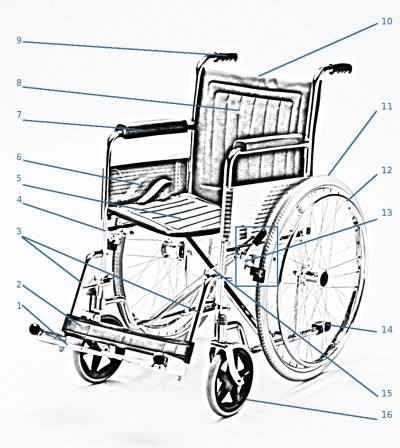
- Footrest
- Legrest
- Front Rigging
- Frame
- Seat
- Metal Skirt
- Armrests
- Backrest
- Push Handles
- Push Axle
- Rear Wheels
- Handrims
- Brakes
- Tipping Lever
- Crossbars
- Caster Wheels
- Anti-Tip Casters (Not Pictured)
1. Footrest: The footrests, which are also called footplates and footpedals, can be adjusted to accommodate different lengths and can also be rotated.
2. Legrest: The legrest extends from the front of the wheelchair and the footrest is attached to the legrest.
3. Front Rigging: The front rigging refers to the footrest arm and the legrest as a single unit. In most conventional wheelchairs, the front rigging can be removed, but this is not always the case in less expensive models. It can also often be elevated to provide an elevated leg rest.
4. Frame: The conventional wheelchairs frame is made out of cold rolled steel that is chrome plated. The frame is the heaviest part of the wheelchair and it can weigh up to 50 pounds, but a stainless steel frame is also available that weighs about ten pounds less.
5. Seat: The seat, like the other fabric parts of a conventional wheelchair, is made from vinyl and uses a sling design. Multiple colors are often available and the vinyl fabric makes it very easy to clean.
6. Metal Skirt: The metal skirt is installed on either side of a conventional wheelchair between the armrests. It is designed to protect the users clothes from dirt, moisture, and debris that can be kicked up by the wheels. Metal Skirts also prevent the users clothes from becoming caught in the wheelchair.
7. Armrests: There are two types of armrests: Full length and Desk Type. The armrests are secured to the frame in two places and are designed to be very sturdy.
8. Backrest: The Backrest height is fixed and typically is about 16 ½ inches high. However, reclining backrests and extending backrest are available as options for most conventional wheelchairs.
9. Push handles: The Push Handles are located on the back of the wheelchair and rubber handles are installed to make them more comfortable.
10. Push Axle: The Push Axle ensures provides support for the push handles and is at a fixed height.
11. Rear Wheels: Typically the rear wheels will be 24 inches in diameter. Both Pneumatic and Solid tires are used. The rear wheels are used for manual propulsion of the wheelchair.
12. Handrims: The handrims extend outwards from the rear wheel. They are typically chrome plated and are used to propel the wheelchair.
13. Brakes: The brakes are located on the large rear wheels. They are typically located on the front of the wheel next to the bottom of the seat.
14. Tipping Lever: The tipping lever extends from the bottom of the frame and is designed to make it easier to move the wheelchair over obstacles, such as curbs. The person pushing the wheelchair will put weight on the tipping lever, which causes the wheelchair to tip backwards.
15. Crossbars: The crossbars are located under the seat and allow the wheelchair to be easily folded for storage and transportation. There are typically no locks to keep the conventional wheelchair from folding, but instead the weight of the user prevents the wheelchair from being folded.
16. Caster Wheels: The wheels of a conventional wheelchair are called caster wheels and are typically 8 inches in diameter. They are typically made of solid rubber, but for outdoor use pneumatic tires are recommended.
17. Anti-Tip Casters (Not Pictured): Anti-Tip Casters are not always present on conventional wheelchairs, but they can usually be added. They are designed to prevent the wheelchair from tipping over backwards. In the event that the wheelchair tips over too far, the anti-tip casters make contact with the ground, preventing it from completely tipping over.
The conventional wheelchair remains one of the most popular and recognized type of manual wheelchairs available. They are often available in a number of different colors and many offer features to make them easier to use, such as removable armrests to make transferring into and out of the wheelchair easier. They can be seen in public areas, like hotels, airports, grocery stores, and hospitals, which offer wheelchairs for their patrons to use.
The Beginning of the Modern Manual Wheelchair
Saturday, April 4th, 2009
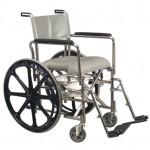 For most, the image of the manual wheelchair is very well known and the first thought when the word wheelchair is mentioned. They are also the oldest type of wheelchair, with records of manual wheelchairs dating back many thousands of years. Of course, these early wheelchairs looked a great deal different from the manual wheelchair of today.
For most, the image of the manual wheelchair is very well known and the first thought when the word wheelchair is mentioned. They are also the oldest type of wheelchair, with records of manual wheelchairs dating back many thousands of years. Of course, these early wheelchairs looked a great deal different from the manual wheelchair of today.
Some of the earliest records of wheelchairs date back to the early Asian empires and are known about only because of the images found by historians. These devices were often simply just wheeled carts and were even sometimes pulled by animals. As time progressed, the wheelchair would continue to develop, but there was not a real standard until the late 1800′s. Up until this point, wheelchairs came in many different sizes and often very cost prohibitive. In most cases, these early wheelchairs were only available to nobility, who had them custom built.
By the beginning of the 1900′s, a wicker wheelchair had become popular, but it was rather heavy to use and could not be self propelled. This changed with the development of the E & J wheelchair. The E & J wheelchair used hollow steel tubing to provide a strong, but lightweight frame. It could also be folded to take up less space and featured large wheels in the back. The wheels were designed so that the wheelchair user could propel themselves without assistance. Since the wheelchair could be folded and was so lightweight, it could be easily traveled with, making it very popular.
Around the same time that the E & J wheelchair was developed, World War II began. During the previous war, World War I, there had been a number of wounded soldiers, but due to the medical conditions, there was not that high of a survival rate. However, by the time World War II had began, there had been a number of improvements in medical care. One of the most important being the discovery of penicillin, which is a powerful antibiotic. As a result, there was large increase soldiers who survived as paraplegics. This increase would drive demand for the E & J wheelchair.
This early wheelchair would form the basis for the modern wheelchair and its basic design is still used today.. Its design being used in almost all forms of manual wheelchairs.